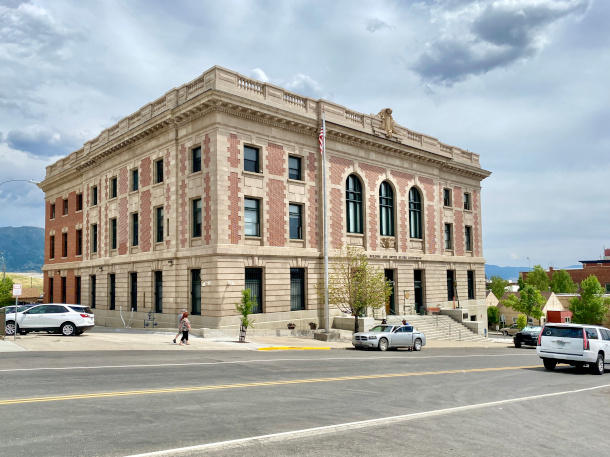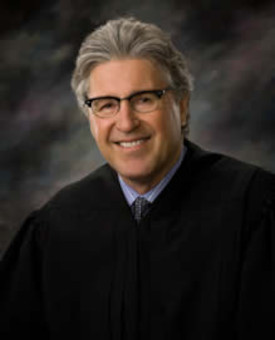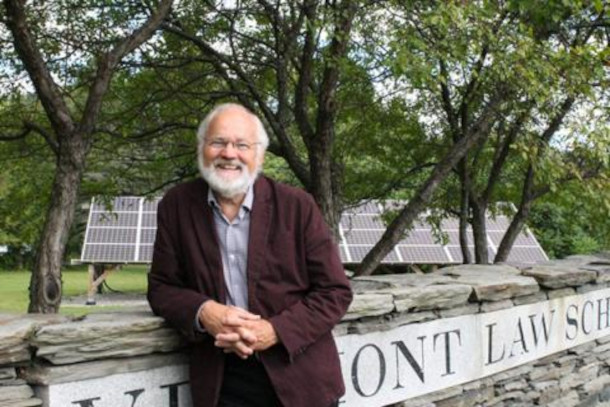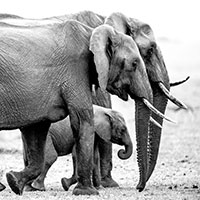Youth Claim Climate Damage by Trump
Air Date: Week of July 4, 2025

The Mike Mansfield Federal Building and United States Courthouse in Butte, Montana, the district where Lighthiser v. Trump was filed. (Photo: Warren LeMay, Flickr, CC BY-SA 2.0)
The new youth climate lawsuit Lighthiser v. Trump is ambitious as it targets specific executive orders and agency actions of the Trump administration. Vermont Law and Graduate School emeritus professor Pat Parenteau offers his views of Lighthiser v. Trump to Host Jenni Doering and explains why he thinks it may have a better chance of making it to trial than the pioneering Juliana youth climate case filed in 2015 which was ultimately blocked by the US Supreme Court before any trial.
Transcript
O’NEILL: It’s Living on Earth, I’m Aynsley O’Neill.
DOERING: And I’m Jenni Doering.
The landmark youth climate case, Juliana v. United States, got bogged down in the courts over whether the plaintiffs even had standing to sue the federal government over its decades-long practice of promoting fossil fuel development. But in the new lawsuit Lighthiser v. Trump, youth plaintiffs like Eva Lighthiser are hoping they can take the crucial step the Juliana case never could and make it to a trial on the merits. A ruling in their favor is the ultimate goal of course, but there are other wins for the climate movement they could notch along the way. During pretrial discovery and the trial itself, representatives for the government would be required to submit documentation and give testimony in depositions and on the witness stand. The Trump administration would be pressed to provide factual testimony, not political spin, and with a steep penalty for perjury, any lies or misleading statements about how fossil fuels contribute to the climate crisis would be risky. Whether or not Lighthiser v. Trump does in fact make it to trial, the case is sure to take a long time to wind its way through the court system. So, in the meantime, the plaintiffs have filed a motion for a preliminary injunction, asking the court to temporarily halt the executive orders and agency actions while the merits of the case are being considered. To help us understand Lighthiser v. Trump, we’re joined by Vermont Law and Graduate School emeritus professor Pat Parenteau. Pat, good to have you back on Living on Earth!
PARENTEAU: Thanks, Jenni, it's a pleasure to be with you.

EPA Administrator Lee Zeldin (left) and President Donald Trump (right). In President Trump’s second term, he has ordered various government agencies to make a number of environmental rollbacks. The youth plaintiffs and their attorneys will be making a case against both Trump and several of his agency heads. (Photo: Shaleah Craighead, Wikimedia Commons, Public Domain)
DOERING: So Pat, what are the legal arguments here in this case, Lighthiser v. Trump?
PARENTEAU: So it's a mix of constitutional claims and statutory claims based on statutes. The Constitutional claims are a right to life and liberty. And by right to life, the plaintiffs are saying it's not just any life, right? It's a healthy life, a right to live in a healthy environment where your future is secure, where your opportunities are available to you to grow and prosper, be happy, even. So, their concept of right to life and liberty is very, very broad, broader than anything the United States Supreme Court has ever recognized. That's the biggest reach of this case, okay? So it's very unlikely that there are five votes on this Supreme Court to recognize that kind of sweeping constitutional right. I applaud the plaintiffs for trying. I think the facts justify recognition of a right like that. I think the science supports what they're claiming as interfering with their right to life and liberty. That's a big reach. The one that intrigues me the most, and there's a sort of a series of claims around this one, is that the President doesn't have the authority to do what he's doing. And we've seen this in other contexts, whether it's deportation, whether it's birthright citizenship. He is an imperial president. Some call him a would-be king. And so one of the thrusts of the Lighthiser case is to say, Trump just doesn't have the authority he's claiming. And so that's what we call ultra vires. You know, that's where an agency, or in this case, the President is simply claiming authority he doesn't have. Presidents have two sources of authority. One is where Congress has passed a law, the Clean Air Act, the Clean Water Act, et cetera, and given to the president both specific authority and specific direction. The other source of authority is less clear, and that's the inherent authority of a president over things like foreign affairs and you know, declaration of emergencies that you know, the President does and has, of course, used repeatedly the power to declare emergencies in response to the disasters, right, that climate change is creating. So the President, in defending against this lawsuit is certainly going to invoke that source of authority. For example, he says there's an energy emergency. By every measure, there is no energy emergency. We are the world's largest producer, exporter of oil and gas in the world, right? In fact, it's hard to actually get companies to bid on some of the oil and gas leases, there's so much oil and gas in the system. So there really is no energy emergency, and if there was, why would you not fund and accelerate renewable energy? Solar energy is the cheapest form of electricity in the country, but his orders either say nothing about renewable energy, or actively are opposing renewable energy through tax credits, through funding and loans and loan guarantees and a whole variety of policies that the Biden administration put in effect. The Trump administration is canceling all of them, and I mean, literally all of them, right? So that's the situation we have with the President asserting these authorities. I think the strongest arguments in this case are going to be challenging his legal authority to do this. Challenging these orders as unconstitutional is a much harder case to make.

Judge Dana L. Christensen, the U.S. district judge assigned to Lighthiser v. Trump. (Photo: United States District Court for the District of Montana, Wikimedia Commons, public domain)
DOERING: It's taken a lot of work, but there have been a few wins for youth climate lawsuits in the past few years, the Montana ruling that Montanans have a constitutional right to a safe climate. There was also that Hawaii lawsuit that resulted in the State Department of Transportation fast tracking greener transit options. So what do you think are the chances that these kids will get anywhere in this lawsuit?
PARENTEAU: I think they are going to accomplish something. They're in front of a very good judge, Judge Christensen in Montana. He is a very smart judge, and he has written some very strong environmental opinions. He's going to be cautious and careful about this one, because it's big, and he knows he's going to be appealed, and it's going to go to the ninth circuit, and then it's probably going to end up in the United States Supreme Court. At least there will be an attempt, depending on who wins and loses in this case, there’s going to be an attempt by somebody to get this in front of the United States Supreme Court, but they've got a good judge to start with, and if they can put on a case that identifies a really egregious individual action of these agencies. I wouldn't go after a kitchen sink approach. I would be more targeted, more strategic, more specific about which of the actions that you're going after can you show are really causing the injuries that the youth plaintiffs are talking about, right? So connecting those individual facts to individual actions, convincing the court that these are really serious problems, serious infringement. These actions can be proven as increasing damage, increasing injury to the plaintiffs. That's the kind of argument that's going to win. But this whole idea that you can get a wholesale order from the court striking down all of these executive orders, blocking all of the actions that are being taken to implement them, that may be too far for the courts to deal with. So more strategic, more focus, they have a chance of actually accomplishing something really significant.
DOERING: Pat, there were some facts that were established in the Montana case that was upheld by the courts. To what extent do those facts that have been established in the courts potentially help this case as it moves along?
PARENTEAU: Well, that's a blueprint. The Held case is a blueprint for the kind of case that you want to put on. The difference is that the Montana Attorney General didn't try to contest any of the facts. They let them all come into evidence, much to their chagrin later on, when the case was upheld by the Montana Supreme Court. The findings of Judge Seeley in the trial court were all upheld. There was over 200 of those kinds of findings. So those findings don't automatically transfer to the federal case, but the plaintiffs now know exactly what kind of case to put on, which experts to call. By the way, one of the breakthroughs in the Held case was the recognition that these impacts on these individual plaintiffs, the heat that they have to contest with and so forth. You know, there was medical testimony that those impacts were not only doing physical harm to the plaintiffs, but psychological harm, that was accepted and recognized in the judge's findings and accepted by the Montana Supreme Court. So I have no doubt that Our Children's Trust lawyers know exactly how to litigate this case, and they will get that kind of evidence in front of Judge Christiansen, and it'll depend on what the judge does, but there's a really good chance that a really strong factual record, an evidentiary record can be built in this case, and that will follow the case all the way up the line as it goes to the circuit court and ultimately, maybe the Supreme Court. So it's critical, obviously, that in the trial, you do everything you can to build the strongest record that you can. I'm sure Our Children's Trust lawyers are going to do that.

Pat Parenteau is a professor at Vermont Law and Graduate School. (Photo: Vermont Law and Graduate School)
DOERING: So Pat, what happens next?
PARENTEAU: Right. So now we're in the early stages of the case. It was just filed in May. And for sure, the government is going to try to dismiss it. They're going to make some of the same arguments they did against Juliana. They're going to argue they don't have standing. They're going to argue the courts don't have authority to review this material. They're going to argue that the President's decision that something is an emergency is not reviewable by the courts at all. So they're going to make all kinds of jurisdictional, as we call it, arguments to throw the case out, and they'll fight like the devil to get the case thrown out. I don't think they will, maybe they'll get it narrowed. I wouldn't be surprised that maybe the judge, as a first move, narrows the case a little bit, or at least says we're going to try these issues to start with, and then we'll see where we go from there. Break it down, because it's a little bit overwhelming when you look at it, to try to do it all at once. So there's going to be a skirmishing over whether there is going to be a trial at all, or whether we at least advance the case to where you're actually making arguments on what we call the merits, right, on whether there is a constitutional right, whether the President does have authority to issue these orders. One other that I didn't mention, I should probably quickly mention, they've argued something called the state-created danger doctrine. This is a doctrine that says, when the government is taking affirmative action that endangers individual lives or well-being, that that can be the source of an argument or a claim against the government. The United States Supreme Court has never recognized this so-called state- created danger doctrine. Some of the circuits have recognized it in different ways. Other circuit U.S., Courts of Appeal, elect, the Fifth Circuit have said there is no such thing. So that's one that's also kind of on the bubble, I think. But I like it because, in a way, it absolutely captures what I would call the gestalt of this case, which is, it's all about danger, right? And it's all about making the danger worse. The danger is incredibly severe, existential even. But the idea that what the government is doing is it knowingly, deliberately putting these young people's lives in danger, that's really powerful. Even if it doesn't result in a sweeping legal victory, it's the kind of argument that sort of captures the essence of what this case is about. So that's what we're going to see as this case moves forward. How many of these claims remain, how many may be dismissed? And as I said, however the initial decision comes out, it will be appealed. If the plaintiffs lose, they will appeal. If the government loses, you can be sure the government will appeal. So whatever happens in Montana, won't stay in Montana. It's going to the ninth circuit, and from there, it's probably going to the Supreme Court.
DOERING: Pat Parenteau is a former EPA Regional Council and emeritus professor at Vermont Law and Graduate School. Thank you so much for joining us, Pat.
PARENTEAU: Thanks, Jenni, good to be with you.
Links
Living on Earth wants to hear from you!
Living on Earth
62 Calef Highway, Suite 212
Lee, NH 03861
Telephone: 617-287-4121
E-mail: comments@loe.org
Newsletter [Click here]
Donate to Living on Earth!
Living on Earth is an independent media program and relies entirely on contributions from listeners and institutions supporting public service. Please donate now to preserve an independent environmental voice.
NewsletterLiving on Earth offers a weekly delivery of the show's rundown to your mailbox. Sign up for our newsletter today!
 Sailors For The Sea: Be the change you want to sea.
Sailors For The Sea: Be the change you want to sea.
 The Grantham Foundation for the Protection of the Environment: Committed to protecting and improving the health of the global environment.
The Grantham Foundation for the Protection of the Environment: Committed to protecting and improving the health of the global environment.
 Contribute to Living on Earth and receive, as our gift to you, an archival print of one of Mark Seth Lender's extraordinary wildlife photographs. Follow the link to see Mark's current collection of photographs.
Contribute to Living on Earth and receive, as our gift to you, an archival print of one of Mark Seth Lender's extraordinary wildlife photographs. Follow the link to see Mark's current collection of photographs.
 Buy a signed copy of Mark Seth Lender's book Smeagull the Seagull & support Living on Earth
Buy a signed copy of Mark Seth Lender's book Smeagull the Seagull & support Living on Earth

